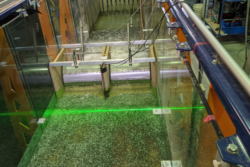
RENEWABLE ENERGY
Austria aims to meet its entire electricity demand from renewable energy sources by 2030. Currently, approximately 60% of the electricity demand is covered by hydropower, with an additional 5 terawatt-hours (TWh) planned for expansion by 2030.
As a renewable energy source, hydropower can make a significant contribution to achieving climate goals. However, every hydropower plant, whether a (pumped) storage plant or a run-of-river plant, represents an intervention in the existing water system. Technical challenges include sediment management and flood protection. From an ecological perspective, key issues include the disruption of river continuity, hydropeaking effects caused by plant operations, the development of fish-friendly and sediment-passable turbines, and the lack of fish migration aids. These challenges require research-driven, innovative solutions and apply to both existing hydropower plants and potential new developments. An integrated approach to hydropower plants necessitates applied and fundamental research in the following areas:
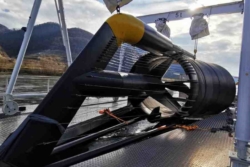
Innovative Turbine Development
Traditional run-of-river plants typically use Kaplan or Francis turbines, which already achieve high efficiency, leaving little room for further improvement in energy efficiency. Therefore, new turbine developments focus on reducing fish mortality during downstream migration through turbines. The “fish-friendliness” of turbines can be enhanced by slower rotation speeds or optimized blade designs. Another research focus is the development of sediment-passable turbines, where factors such as appropriate coatings, structural design, and turbine placement within the hydropower plant play a central role. Hydrokinetic turbines, which harness the kinetic energy of flowing water without impoundment, represent another innovative approach. These turbines have a significantly lower impact on the river system compared to run-of-river plants, though they also produce less annual energy output.
The hydropower test facility at the BOKU Hydraulic Engineering Laboratory provides the opportunity to test innovative turbine designs at near full-scale conditions.
Optimization of Hydropower Plants
Existing hydropower plants often require optimization due to new technical and structural demands, necessary adaptations to (climate change-induced) hydrological changes, or for the renewal of water rights. A key aspect of optimization involves upgrading outdated turbines, generators, and control systems. Such measures can often lead to performance improvements, even with increased residual water releases, creating a “win-win” situation from technical, ecological, and socio-economic perspectives.
Additionally, new hydrological conditions, such as more frequent and intense extreme events, necessitate adaptations to hydraulic structures within the plant. This includes optimizing weir thresholds and stilling basin geometries, as well as modifying existing bed reinforcements in head and tail water , trash rack systems, or hydraulic steel structures.
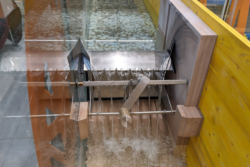
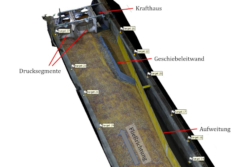
Reservoir Management and Design
The sediment continuity of many rivers in the Alpine region is disrupted by hydropower plants, as a significant portion of sediment load is often retained in reservoirs during operation. This can lead to increased flood risks, technical issues in plant operation, and sediment deficits downstream, resulting in erosion problems. Therefore, the development of sustainable sediment management strategies is essential. For example, high-flow events can be utilized for flushing operations to mobilize sediments deposited in reservoirs and transport them downstream. The flow rate required to initiate flushing should balance efficiency and ecological considerations, such as suspended sediment and organic material concentrations. Additionally, repeated drawdowns during moderate sediment-transporting flows can enable sediment sluicing through the reservoir. Efficiency can be further enhanced through structural measures (e.g., sediment guiding structures, sediment bypass channels) and optimized operational strategies (e.g., drawdown concepts for cascaded plants, operational response diagrams).
Beyond measures within the reservoir itself, bypass systems (e.g., bypass channels or tunnels) can further improve sediment continuity.
Fish Migration Aids
Fish migration aids are integral components of run-of-river plants, ensuring the safe upstream and downstream passage of fish and other aquatic organisms. Key elements of fish migration aids include their detectability and placement, sufficient attraction flow compared to competing discharges, adherence to maximum flow velocities and water level differences based on target fish species, and functionality over extended periods of the year (e.g., for 300 days a year). From an energy perspective, the residual water allocated to fish migration is unavailable for electricity production. Innovative developments, such as residual water turbines, aim to combine fish migration with energy generation. One example is the Fishcon fish migration aid, characterized by its compact, space-saving design and bidirectional passability. Fishcon was developed between 2016 and 2020, among others, at the BOKU Hydraulic Engineering Laboratory.
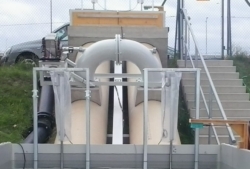
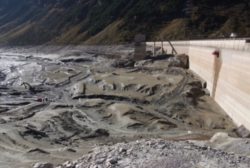
Sediment Management
Sediment is introduced into a river system through erosion processes in the catchment area. In an undisturbed state, this sediment is transported downstream over time and eventually reaches the sea. However, hydropower plants and other structures disrupt these transport processes, leading to sediment surpluses in reservoirs and deficits downstream. This results in reservoir capacity losses, reduced plant efficiency, and increased erosion rates in estuarine areas, which in turn contribute to land loss in coastal regions. The goal of regulated sediment management is to improve sediment continuity at impoundments to restore sediment balance. Various technical and organizational measures can be employed, targeting three areas: preventing sediment entry into the reservoir (e.g., catchment management, bypasses), reducing sediment deposition rates (e.g., sluicing), and removing already deposited sediment (e.g., flushing, dredging). The suitability of specific methods depends on local conditions and must be determined on a case-by-case basis. Furthermore, individual methods can continue to be optimized.
Flood Risk Management at Hydropower Plants
Climate change-induced and natural changes in hydrological conditions in Alpine rivers necessitate continuous adaptation of flood risk management strategies to ensure the safe operation of hydropower plants. This includes improving existing drawdown concepts for individual plants based on new extreme value statistics and corresponding discharge capacity curves, as well as the holistic optimization of decision-making diagrams for the operation of cascaded plants, integrating flood protection, sedimentological, and ecological objectives.
In addition to operational measures to minimize flood risks, structural optimizations of existing hydropower plants are often required to ensure the safe and damage-free discharge of extreme flows (see “Optimization of Hydropower Plants”).
